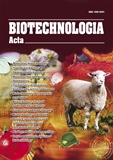ISSN 2410-7751 (Print)
ISSN 2410-776X (Online)

Biotechnologia Acta Т. 18, No. 2, 2025
P. 24-27 , Bibliography 9 , Engl.
UDC UDC 547.56:615.322:582.734.4
doi: https://doi.org/10.15407/biotech18.02.024
CHERRY LAUREL (PRUNUS LAUROCERASUS) EXTRACT AND LİPOSOME ENCAPSULATION
Esma Nur BULUT1, Can Ali AĞCA2, Nilgün ERTAŞ3
1 Department of Food Technology, Food Agriculture and Livestock Vocational School, Bingöl University, TÜRKİYE
2 Department of Molecular Biology and Genetics, Bingöl University, TÜRKİYE
3 Department of Food Engineering, Engineering Faculty, Necmettin Erbakan University, Koyceğiz Campus, Konya, TÜRKİYE
Aim. The study aimed to determine the antioxidant activity and the number of phenolic substances of cherry laurel fruit and to reveal the usability of the fruit for other studies.
Methods. Cherry laurel fruit was separated from the seeds and pureed. The fruit was extracted by ultrasonic extraction. Ethanol was used as a solvent. The fruit was extracted by acidic and ethanol extraction. The solvent was removed in a rotary evaporator at 50–60 ºC. For liposome production, lecithin solution was first prepared. Chitosan solution was added to the resulting reduced-size liposome and mixed overnight. Liposomes with and without extracts were prepared.
Results. The DPPH value of the acidic fruit extract was determined as 66.399 mg TEAA/kg KM, the CUPRAC analysis result was 42.424,84 mg/kg KM, and the total phenolic content was 3.895,34 mg GAE/kg KM.
Conclusions. The data obtained from this study show that cherry laurel fruit has good antioxidant activity and phenolic substance content and that the fruit can be a raw material for anticancer studies in this field.eywords: Antioxidant and phenolic, Cherry laurel, Encapsulation, Liposome.
Keywords: Antioxidant and phenolic, Cherry laurel, Encapsulation, Liposome.
© Palladin Institute of Biochemistry of the National Academy of Sciences of Ukraine, 2025
Referencers
1. Ayaz, F., Kadiog, A., Reunanen, M. (1997). Sugar composition in fruits oflaurocerasus officinalis
roem. and its three cultivars. Journal of Food Composition and Analysis. 10, 82–86. https://doi.org/10.1006/jfca.1997.0519
2. Kolayli, S., Küçük M., Duran, C., Candan, F., Dinçer, B. (2003). Chemical and antioxidant properties
of Laurocerasus officinalis Roem.(cherry laurel) fruit grown in the Black Sea region. Journal of
Agricultural and Food Chemistry, 51, 7489–7494.
3. Karataş, E., Uçar, A. Karayemiş’in Sağlık Üzerine, Etkisi. (2018). Sağlık Bilimleri Dergisi, 27,
70–75.
4. Çalışır, S., Aydın, C. (2004). Some physico-mechanic proper ties of cherry laurel (Prunus
lauracerasus L.) fruits. Journal of Food Engineering, 65, 145–150. https://doi.org/10.1016/j.jfoodeng.2004.01.009
5. İslam, A. (2002). Kiraz’cherry laurel (Prunus laurocerasus). Journal of Crop and Horticultural
Science, 30, 301–302. https://doi.org/10.1080/01140671.2002.9514227
6. Baytop, T. (2001). Therapy with medicinal plants in Turkey (past and present), 1st ed. Istanbul
University: Istanbul, Turkey. P. 178–249.
7. Talih, M. (2018). Dondurarak Kurutma Yöntemi İle Taflan (Karayemiş) (Prunus laurocerasus L.)
Meyvesinin Kurutulması ve Örnek Gıda Sisteminde Denenmesi. Master Thesis, EÜ Institute of
Science and Technology. İzmir.
8. Yaylacı-Karahalil, F., Şahin, H. (2011). Phenolic composition and antioxidant capacity of Cherry
laurel (Laurocerasus officinalis Roem.) sampled from Trabzon region. Biotechnology, 10(72),
16293–16299.
9. Uğurlu, S., Bakkalbaşı, E. (2023). Elma kabuğundan fenolik maddelerin ultrases destekli
ekstraksiyonu. Food and Health. 9(4), 341–349. https://doi.org/10.3153/FH23031.
10. Wolfe, K. L., Liu, R. H. (2003). Apple Peels as a Value-Ad ded Food Ingredient. Journal of
Agricultural and Food Chemistry, 51, 1676–1683. https://doi.org/10.1021/jf025916z
11. Roohinejad, S., Koubaa, M., Barba, F. J., Greiner, R., Orlien, V., Lebovka, N. I. (2016). Negative
pressure cavitation extraction: A novel method for extraction of food bioactive compounds from
plant materials. Trends in Food Science and Technology, 52, 98–108.
12. Topdaş, E. F., Şengül, M. (2019). Katı-sıvı Ekstraksiyonunda kullanılan modern Teknikler ve bu
Teknikler arasında ultrason Yardımlı Ekstrak siyonun yeri. Atatürk Üniversitesi Ziraat Fakültesi
Dergisi. 201–216.
13. Taşkıran, Z. G., Dündar, A., Yıldız, H. (2023). Bitkisel materyallerdeki biyoaktif bileşenlerin
ekstraksiyonunda kullanılan konvansiyonel ve yeni nesil ekstraksiyon yöntemleri. Food Science
and Engineering Research, 2(2), 50–58.
14. Picó, Y. (2013). Ultrasound-assisted extraction for food and environmen tal samples. TrAC Trends
in Analytical Chemistry, 43, 84–99. https://doi.org/10.1016/j.trac.2012.12.005
15. Siddiqui, H., Sultan, Z., Yousuf, O., Malik, M., Younis, K. (2023). A review of the health benefits,
functional properties, and ultrasound-assisted dietary fiber extraction. Bioactive Carbohydrates
and Dietary Fibre, 30, 100356.
16. Allen, T. M., Cullis, P. R. (2013). Liposomal drug delivery systems: From concept to clinical
applications. Advanced Drug Delivery Reviews, 65(1), 36–48. https://doi.org/10.1016/j.addr.2012.09.037
17. Demircan, E. (2016). Elma Kabuklarından Elde Edilen Bileşiklerin Lipozom ile Enkapsülasyonu.
Istanbul Technical University, Institute of Science and Technology. İstanbul.
18. Beta, T., Nam, S., Dexter, J. E., Sapirstein, H. D. (2005). Phenolic content and antioxidant
activitiy of pearled wheat and roller-milled fractions. Cereal Chemistry, 82(4), 390–393.
19. Gyamfi, M. A., Yonamine, M., Aniya, Y. (1999). Free radical scavenging action of medical herbs
from ghane: thonningia sanguinea on experimentally-induced liver injuries. General Pharma,
32(6), 661–667. https://doi.org/10.1016/S0306-3623(98)00238-9
20. Maurya, S., Singh, D. (2010). Quantitative analysis of total phenolic content in Adhatoda vasica
Nees extracts. International Journal of PharmTechonology Research, 2(4), 2403–2406.
21. Stalikas, C.D. (2007). Determination of phenolic compounds in olive oils: A review. Food
Chemistry, 100(4), 1329–1336.

